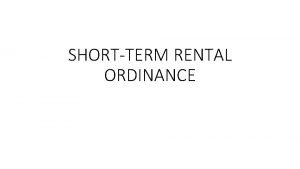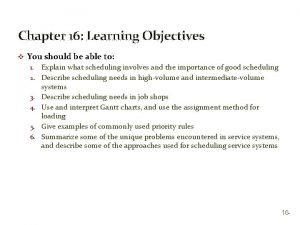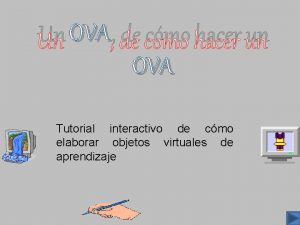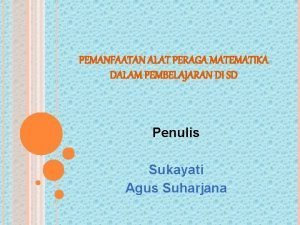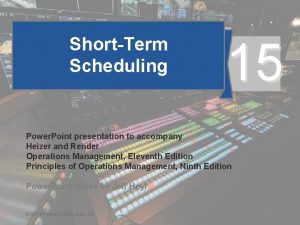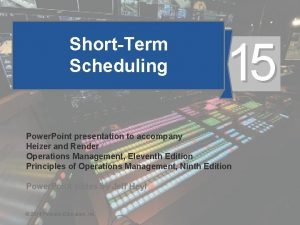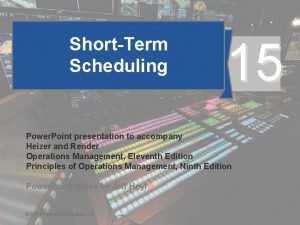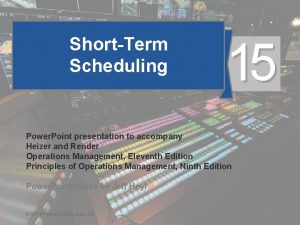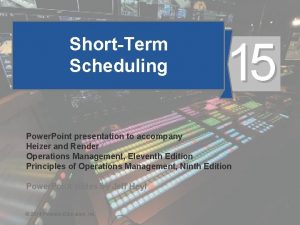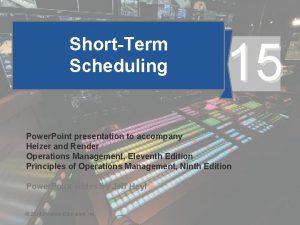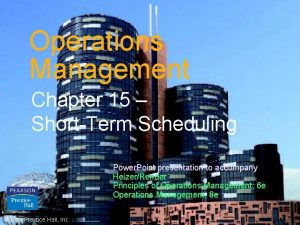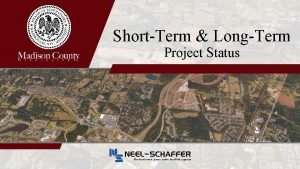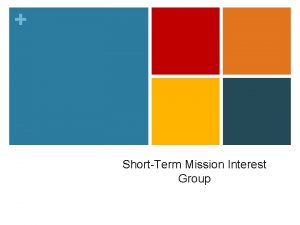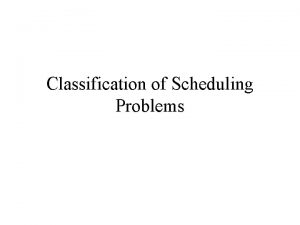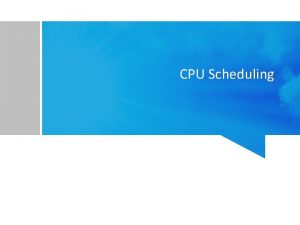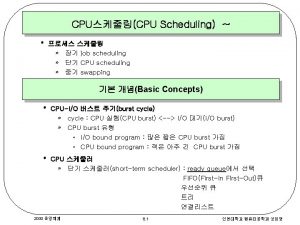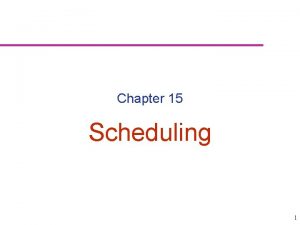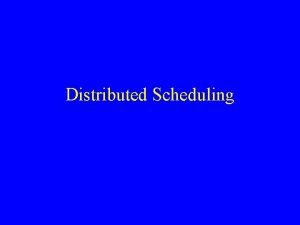Scheduling in the ShortTerm 15 Power Point presentation















































































- Slides: 79

Scheduling in the Short-Term 15 Power. Point presentation to accompany Heizer and Render Operations Management, Global Edition, Eleventh Edition Principles of Operations Management, Global Edition, Ninth Edition Power. Point slides by Jeff Heyl © 2014 Pearson Education 15 - 1

The Hierarchy of Production Decisions The logical sequence of operations in either a manufacturing or service system corresponds to the sequencing of chapters in an Operations Management text book. ▶ All planning starts with the demand forecast. ▶ Demand forecasts are the basis for the top level (aggregate) planning. ▶ The Master Production Schedule (MPS) is the result of disaggregating aggregate plans down to the individual item level. ▶ Based on the MPS, MRP is used to determine the size and timing of component and subassembly production. ▶ Detailed shop floor schedules are required to meet production plans resulting from the MRP. © 2014 Pearson Education 15 - 2

Hierarchy of Production Decisions © 2014 Pearson Education 15 - 3

Scheduling Flow Figure 15. 1 © 2014 Pearson Education 15 - 4

Scheduling Decisions TABLE 15. 1 Scheduling Decisions ORGANIZATION MANAGERS SCHEDULE THE FOLLOWING Air Lines Maintenance of aircraft Departure timetables Flight crews, catering, gate, ticketing personnel Operating room use Patient admissions Nursing, security, maintenance staffs Outpatient treatments Classrooms and audiovisual equipment Student and instructor schedules Graduate and undergraduate courses Production of goods Purchases of materials Workers Hospital University Factory © 2014 Pearson Education 15 - 5

Short-Term Scheduling The objective of scheduling is to allocate and prioritize demand (generated by either forecasts or customer orders) to available facilities © 2014 Pearson Education 15 - 6

Importance of Short-Term Scheduling ▶ Effective and efficient scheduling can be a competitive advantage ▶ Faster movement of goods through a facility means better use of assets and lower costs ▶ Additional capacity resulting from faster throughput improves customer service through faster delivery ▶ Good schedules result in more dependable deliveries © 2014 Pearson Education 15 - 7

Scheduling Issues 1. Forward or backward scheduling 2. Finite or infinite loading 3. Scheduling Criteria © 2014 Pearson Education 15 - 8

Forward Scheduling (Hospitals, Restaurants, Machine Tool Manufacturers) ▶ Forward scheduling starts as soon as the requirements are known to determine the shipping date or the due date. ▶ Frequently results in buildup of work-inprocess inventory Now © 2014 Pearson Education Due Date 15 - 9

Backward Scheduling (Wedding Organization, Catering a Banquet) ▶ Backward scheduling begins with the due date and schedules the final operation first (MRP) ▶ Schedule is produced by working backwards though the processes ▶ Resources may not be available to Due accomplish the Now Date schedule © 2014 Pearson Education 15 - 10

Forward and Backward Scheduling ▶ Backward scheduling begins with the due date and schedules thesfinal operation first e r a e h c a ro e p d p a r a t ▶ Schedulethis produced by working e a s p e o l e n v e e t f y d t i O o c t backwards though the processes a d p e a n c i r b n e e m m e o co t w s et u b c f f d o n ▶ Resources amay anot s t n i s n r t o i s t n a t c co be available to e p x e accomplish the Due schedule Now Date © 2014 Pearson Education 15 - 11

Finite and Infinite Loading ▶ Assigning jobs to work stations ▶ Finite loading assigns work up to the capacity of the work station ▶ All work gets done ▶ Due dates may be pushed out ▶ Infinite loading does not consider capacity ▶ All due dates are met ▶ Capacities may have to be adjusted © 2014 Pearson Education 15 - 12

Scheduling Criteria 1. Minimize completion time 2. Maximize utilization of facilities 3. Minimize work-in-process (WIP) inventory 4. Minimize customer waiting time © 2014 Pearson Education 15 - 13

Different Processes/ Different Scheduling Approaches Process-focused Repetitive facilities (job shops) (assemble lines) Product-focused (continuous) Number of inputs Schedule orders Typical focus of the master production schedule Schedule modules Number of end items Schedule finished product Examples: Print shop Machine shop Fine-dining restaurant © 2014 Pearson Education Motorcycles Autos, TVs Fast-food restaurant Steel, Beer, Bread Lightbulbs Paper 15 - 14

Different Processes/ Different Scheduling Approaches TABLE 15. 2 Process-focused facilities (job shops) Scheduling to customer orders where changes in both volume and variety of jobs/clients/patients are frequent ►Schedules are often due-date focused, with loading refined by finite loading techniques ►Examples: foundries, machine shops, cabinet shops, print shops, many restaurants, and the fashion industry ► © 2014 Pearson Education 15 - 15

Different Processes/ Different Scheduling Approaches TABLE 15. 2 Repetitive facilities (assembly lines) üSchedule module production and product assembly based on frequent forecasts üFinite loading with a focus on generating a forwardlooking schedule üJIT techniques are used to schedule components that feed the assembly line Examples: assembly lines for washing machines at Whirlpool and automobiles at Ford. © 2014 Pearson Education 15 - 16

Different Processes/ Different Scheduling Approaches TABLE 15. 2 Product-focused facilities (continuous) Schedule high volume finished products of limited variety to meet a reasonably stable demand within existing fixed capacity ►Finite loading with a focus on generating a forwardlooking schedule that can meet known setup and run times for the limited range of products ►Examples: huge paper machines at International Paper, beer in a brewery at Anheuser-Busch, and potato chips at Frito-Lay ► © 2014 Pearson Education 15 - 17

Scheduling Process-Focused Systems Typical activities are: ▶ Loading: Allocating orders, equipments, and personnel to work centers or other specified location-Short term capacity planning; ▶ Sequencing: Determining the order in which jobs will be processed. (i. e. job priorities); ▶ Controlling the progress of orders as they are being worked on; ▶ Expediting the late and critical orders; ▶ Revising the schedules in light of changes in order status. © 2014 Pearson Education 15 - 18

Loading Jobs Techniques used for Loading Jobs so that costs, idle time or completion times can be minimized ØInput-Output Control ØCon. WIP Cards ØGantt Charts ØAssignment Method © 2014 Pearson Education 15 - 19

Input-Output Control ▶ Allows operational personnel to manage facility work flows ▶ Identifies overloading and underloading conditions ▶ Prompts managerial action to resolve scheduling problems ▶ Input-output control can be maintained using Con. WIP (Constant Work-In-Process) cards that control the amount of work in a work center. © 2014 Pearson Education 15 - 20

Input-Output Control Example © 2014 Pearson Education 15 - 21

Figure 15. 2 Input-Output Control Example Work Center DNC Milling (in standard hours) Week Ending 6/6 6/13 6/20 6/27 7/4 Planned Input 280 280 280 Actual Input 270 250 285 280 Cumulative Deviation – 10 – 40 – 35 Planned Output 320 320 Actual Output 270 270 Cumulative Deviation – 50 – 100 – 150 – 200 0 – 20 – 10 +5 Cumulative Change in Backlog © 2014 Pearson Education 7/11 15 - 22

Figure 15. 2 Input-Output Control Example Work Center DNC Milling (in standard hours) Week Ending 6/6 6/13 6/20 6/27 7/4 Planned Input 280 280 280 Actual Input 270 250 285 280 – 10 – 40 – 35 320 320 Actual Output 270 270 Cumulative Deviation – 50 – 100 – 150 – 200 0 – 20 – 10 +5 Explanation: Cumulative Deviation 270 input, 270 output implies Planned Output 0 change Cumulative Change in Backlog © 2014 Pearson Education 7/11 Explanation: 250 input, 270 output implies – 20 change 15 - 23

Gantt Charts ▶ Shows the loading and idle times of departments, machines, or facilities ▶ Displays relative workloads over time ▶ Indicates which jobs are on schedule, and which ahead of or behind schedule ▶ All Gantt charts need to be updated frequently to account for changes © 2014 Pearson Education 15 - 24

Gantt Load Chart Example Figure 15. 3 Day Work Center Metalworks Monday Tuesday Job 349 Painting Processing © 2014 Pearson Education Friday Job 350 Mechanical Electronics Wednesday Thursday Job 349 Job 408 Job 349 Job 295 Unscheduled Job 408 Job 349 Center not available 15 - 25

Gantt Schedule Chart Example Figure 15. 4 Job Day 1 Day 2 Day 3 Day 4 Day 5 A B Day 6 Day 7 Day 8 Start of an activity End of an activity Scheduled activity time allowed Actual work progress Maintenance Nonproduction time C Point in time when chart is reviewed Now © 2014 Pearson Education 15 - 26

Assignment Method ▶ A special class of linear programming models that assigns tasks or jobs to resources ▶ Objective is to minimize cost or time ▶ Only one job (or worker) is assigned to one machine (or project) © 2014 Pearson Education 15 - 27

Assignment Method ▶ Build a table of costs or time associated with particular assignments TYPESETTER JOB A B C R-34 $11 $14 $ 6 S-66 $ 8 $10 $11 T-50 $ 9 $12 $ 7 © 2014 Pearson Education 15 - 28

Assignment Method (finds the lowest opportunity cost for each assignment) 1. Create zero opportunity costs by repeatedly subtracting the lowest costs from each row and column 2. Draw the minimum number of vertical and horizontal lines necessary to cover all the zeros in the table. If the number of lines equals either the number of rows or the number of columns, proceed to step 4. Otherwise proceed to step 3. © 2014 Pearson Education 15 - 29

Assignment Method 3. Subtract the smallest number not covered by a line from all other uncovered numbers. Add the same number to any number at the intersection of two lines. Return to step 2. 4. Optimal assignments are at zero locations in the table. Select one, draw lines through the row and column involved, and continue to the next assignment. © 2014 Pearson Education 15 - 30

Assignment Example Typesetter Job R-34 S-66 T-50 Step 1 a - Rows B C $11 $ 8 $ 9 $14 $10 $12 $ 6 $11 $ 7 Step 1 b - Columns Typesetter A Job R-34 S-66 T-50 A $ 5 $ 0 $ 2 © 2014 Pearson Education B $ 8 $ 2 $ 5 C $ 0 $ 3 $ 0 Job R-34 S-66 T-50 A B C $ 5 $ 0 $ 2 $ 6 $ 0 $ 3 $ 0 15 - 31

Assignment Example Step 2 - Lines Typesetter Job R-34 S-66 T-50 A B C $ 5 $ 0 $ 2 $ 6 $ 0 $ 3 $ 0 Smallest uncovered number Because only two lines are needed to cover all the zeros, the solution is not optimal © 2014 Pearson Education The smallest uncovered number is 2 so this is subtracted from all other uncovered numbers and added to numbers at the intersection of lines Step 3 - Subtraction Typesetter Job R-34 S-66 T-50 A B C $ 3 $ 0 $ 4 $ 0 $ 1 $ 0 $ 5 $ 0 15 - 32

Assignment Example Start by assigning R-34 to worker C as this is the only possible assignment for worker C. Step 2 - Lines Typesetter Job R-34 S-66 T-50 A B C $ 3 $ 0 $ 4 $ 0 $ 1 $ 0 $ 5 $ 0 Because three lines are needed, the solution is optimal and assignments can be made © 2014 Pearson Education Job T-50 must go to worker A as worker C is already assigned. This leaves S-66 for worker B. Step 4 - Assignments Typesetter Job R-34 S-66 T-50 A B C $ 3 $ 0 $ 4 $ 0 $ 1 $ 0 $ 5 $ 0 15 - 33

Assignment Example Typesetter A Job R-34 S-66 T-50 $11 $ 8 $ 9 © 2014 Pearson Education B $14 $10 $12 C $ 6 $11 $ 7 Typesetter Job R-34 S-66 T-50 A B C $ 3 $ 0 $ 4 $ 0 $ 1 $ 0 $ 5 $ 0 15 - 34

Sequencing Jobs ▶ Specifies the order in which jobs should be performed at work centers ▶ Priority rules are used to dispatch or sequence jobs ▶ FCFS: First come, first served ▶ SPT: Shortest processing time ▶ EDD: Earliest due date ▶ LPT: Longest processing time ▶ CR: Critical Ratio © 2014 Pearson Education 15 - 35

Sequencing Example Apply the four popular sequencing rules to these five jobs Job A B C D E © 2014 Pearson Education Job Work (Processing) Time (Days) 6 2 8 3 9 Job Due Date (Days) 8 6 18 15 23 15 - 36

Sequencing Example FCFS: Sequence A-B-C-D-E Job Sequence Job Work (Processing) Time Flow Time Job Due Date Job Lateness A 6 6 8 0 B 2 8 6 2 C 8 16 18 0 D 3 19 15 4 E 9 28 23 5 28 77 © 2014 Pearson Education 11 15 - 37

Sequencing Example FCFS: Sequence A-B-C-D-E Sum of total flow time Number of jobs Average completion time = = 77/5 = 15. 4 days Total job work time Utilization metric = Sum of total flow time = 28/77 = 36. 4% Sum of total flow time Average number of = = 77/28 = 2. 75 jobs in the system Total job work time Average job lateness = © 2014 Pearson Education Total late days Number of jobs = 11/5 = 2. 2 days 15 - 38

Sequencing Example SPT: Sequence B-D-A-C-E Job Sequence Job Work (Processing) Time Flow Time Job Due Date Job Lateness B 2 2 6 0 D 3 5 15 0 A 6 11 8 3 C 8 19 18 1 E 9 28 23 5 28 65 © 2014 Pearson Education 9 15 - 39

Sequencing Example SPT: Sequence B-D-A-C-E Average completion time = Sum of total flow time = 65/5 = 13 days Number of jobs Total job work time Utilization metric = Sum of total flow time = 28/65 = 43. 1% Average number of jobs in the system = Sum of total flow time = 65/28 = 2. 32 jobs Total job work time Average job lateness = © 2014 Pearson Education Total late days Number of jobs = 9/5 = 1. 8 days 15 - 40

Sequencing Example EDD: Sequence B-A-D-C-E Job Sequence Job Work (Processing) Time Flow Time Job Due Date Job Lateness B 2 2 6 0 A 6 8 8 0 D 3 11 15 0 C 8 19 18 1 E 9 28 23 5 28 68 © 2014 Pearson Education 6 15 - 41

Sequencing Example EDD: Sequence B-A-D-C-E Average completion time = Sum of total flow time = 68/5 = 13. 6 days Number of jobs Total job work time Utilization metric = Sum of total flow time = 28/68 = 41. 2% Average number of jobs in the system = Sum of total flow time = 68/28 = 2. 43 jobs Total job work time Total late days Average job lateness = Number of jobs = 6/5 = 1. 2 days © 2014 Pearson Education 15 - 42

Sequencing Example LPT: Sequence E-C-A-D-B Job Sequence Job Work (Processing) Time Flow Time Job Due Date Job Lateness E 9 9 23 0 C 8 17 18 0 A 6 23 8 15 D 3 26 15 11 B 2 28 6 22 28 103 © 2014 Pearson Education 48 15 - 43

Sequencing Example LPT: Sequence E-C-A-D-B Average completion time = Sum of total flow time = 103/5 = 20. 6 days Number of jobs Total job work time Utilization metric = Sum of total flow time = 28/103 = 27. 2% Sum of total flow time Average number of = = 103/28 = 3. 68 jobs in the system Total job work time Average job lateness = © 2014 Pearson Education Total late days Number of jobs = 48/5 = 9. 6 days 15 - 44

Sequencing Example Summary of Rules Rule Average Completion Time (Days) Utilization Metric (%) Average Number of Jobs in System FCFS 15. 4 36. 4 2. 75 2. 2 SPT 13. 0 43. 1 2. 32 1. 8 EDD 13. 6 41. 2 2. 43 1. 2 LPT 20. 6 27. 2 3. 68 9. 6 © 2014 Pearson Education Average Lateness (Days) 15 - 45

Comparison of Sequencing Rules ▶ No one sequencing rule excels on all criteria 1. SPT does well on minimizing flow time and number of jobs in the system ► But SPT moves long jobs to the end which may result in dissatisfied customers 2. FCFS does not do especially well (or poorly) on any criteria but is perceived as fair by customers 3. EDD minimizes maximum lateness © 2014 Pearson Education 15 - 46

Limitations of Rule-Based Dispatching Systems 1. Scheduling is dynamic and rules need to be revised to adjust to changes 2. Rules do not look upstream or downstream 3. Rules do not look beyond due dates © 2014 Pearson Education 15 - 47

Critical Ratio (CR) ▶ An index number found by dividing the time remaining until the due date by the work time remaining on the job ▶ Jobs with low critical ratios are scheduled ahead of jobs with higher critical ratios ▶ Performs well on average job lateness criteria Time remaining Due date – Today’s date CR = = Workdays remaining Work (lead) time remaining © 2014 Pearson Education 15 - 48

Critical Ratio Example Currently Day 25 JOB A B C DUE DATE 30 28 27 CRITICAL RATIO (30 - 25)/4 = 1. 25 (28 - 25)/5 =. 60 (27 - 25)/2 = 1. 00 WORKDAYS REMAINING 4 5 2 PRIORITY ORDER 3 1 2 With CR < 1, Job B is late. Job C is just on schedule and Job A has some slack time. © 2014 Pearson Education 15 - 49

Critical Ratio Technique 1. Helps determine the status of specific jobs 2. Establishes relative priorities among jobs on a common basis 3. Adjusts priorities automatically for changes in both demand job progress 4. Dynamically tracks the job progress © 2014 Pearson Education 15 - 50

Sequencing N Jobs on Two Machines: Johnson’s Rule ▶ Works with two or more jobs that pass through the same two machines or work centers ▶ Minimizes total production time and idle time ▶ Johnson’s Rule requires satisfying the following conditions: © 2014 Pearson Education 15 - 51

Johnson’s Rule Conditions ▶ Job times must be known and constant ▶ Job times must be independent of sequence ▶ Jobs must follow the same two-step sequence ▶ All units must be completed at the first work center before moving to second © 2014 Pearson Education 15 - 52

Johnson’s Rule 1. List all jobs and times for each work center 2. Choose the job with the shortest activity time. If that time is in the first work center, schedule the job first. If it is in the second work center, schedule the job last. 3. Once a job is scheduled, it is eliminated from the list 4. Repeat steps 2 and 3 working toward the center of the sequence © 2014 Pearson Education 15 - 53

Johnson’s Rule Example JOB A B C D E WORK CENTER 1 (DRILL PRESS) 5 3 8 10 7 © 2014 Pearson Education WORK CENTER 2 (LATHE) 2 6 4 7 12 15 - 54

Johnson’s Rule Example JOB A B C D E WORK CENTER 1 (DRILL PRESS) 5 3 8 10 7 © 2014 Pearson Education WORK CENTER 2 (LATHE) 2 6 4 7 12 B E D C A 15 - 55

Johnson’s Rule Example JOB A B C D E Time WC 1 WORK CENTER 1 (DRILL PRESS) 5 3 8 10 7 0 3 B WORK CENTER 2 (LATHE) 2 6 4 7 12 10 E B 20 D E D 28 C C A 33 A Idle WC 2 Job completed © 2014 Pearson Education 15 - 56

Johnson’s Rule Example JOB A B C D E Time WC 1 WORK CENTER 1 (DRILL PRESS) 5 3 8 10 7 0 3 10 B E B 20 E D 28 D C A 33 C A Idle WC 2 Time 0 1 WORK CENTER 2 (LATHE) 2 6 4 7 12 B 3 5 E 7 9 10 11 12 13 B © 2014 Pearson Education D 17 19 21 22 2325 E C 27 29 D 31 A Job 33 35 completed C A 15 - 57

Finite Capacity Scheduling (FCS) Systems ▶ It is a computerized short-term scheduling system ▶ Overcomes disadvantages of rulebased systems by providing an interactive, computer-based graphical system ▶ May include rules and expert systems or simulation to allow real-time response to system changes © 2014 Pearson Education 15 - 58

Finite Capacity Scheduling (FCS) Systems Planning Data • Master schedule • BOM • Inventory Priority rules • Expert systems • Simulation models Interactive Finite Capacity Scheduling • Routing files • Work center information Tooling and other resources Setups and run time Figure 15. 5 © 2014 Pearson Education 15 - 59

Popular FCS Software Packages ▶ Lekin ▶ Pro. Planner ▶ Preactor ▶ Asprova ▶ Schedlyzer ▶ Jobplan © 2014 Pearson Education 15 - 60

Lekin Finite Capacity Scheduling Software Figure 15. 6 © 2014 Pearson Education 15 - 61

Scheduling Services Service systems differ from manufacturing MANUFACTURING SERVICES Schedules machines and materials Schedule staff Inventories used to smooth demand Seldom maintain inventories Machine-intensive and demand Labor-intensive and demand may be smooth may be variable Few social or behavioral issues Social and behavioral issues may be quite important © 2014 Pearson Education 15 - 62

Scheduling Services ▶ Hospitals have complex scheduling system to handle complex processes and material requirements (often not FCFS, they use ‘triage’ approach ▶ Banks use a cross-trained and flexible workforce and part-time workers ▶ Retail stores use scheduling optimization systems such as Workbrain, Cybershift that track sales, transactions, and customer traffic to create work schedules in less time and with improved customer satisfaction © 2014 Pearson Education 15 - 63

Scheduling Services ▶ Airlines must meet complex to. FAA (Federal Aviation Administration) and union regulations schedule flight crews and often use linear programming to develop optimal schedules ▶ 24/7 operations like police/fire departments, emergency hot lines, and mail order businesses use flexible workers and variable schedules, often created using computerized systems © 2014 Pearson Education 15 - 64

Scheduling Service Employees With Cyclical Scheduling ▶ Objective is to meet staffing requirements with the minimum number of workers ▶ Schedules need to be smooth and keep personnel happy ▶ Many techniques exist from simple algorithms to complex linear programming solutions © 2014 Pearson Education 15 - 65

Cyclical Scheduling Example 1. Determine the staffing requirements 2. Identify two consecutive days with the lowest total requirements and assign these as days off 3. Make a new set of requirements subtracting the days worked by the first employee 4. Apply step 2 to the new row 5. Repeat steps 3 and 4 until all requirements have been met © 2014 Pearson Education 15 - 66

Cyclical Scheduling Example (Schedule 5 -day work-week with 2 consecutive days off) DAY M T W T F S S Staff required 5 5 6 5 4 3 3 M T W T F S S 5 5 6 5 4 3 3 Employee 1 Capacity (Employees) Excess Capacity © 2014 Pearson Education 15 - 67

Cyclical Scheduling Example DAY M T W T F S S Staff required 5 5 6 5 4 3 3 M T W T F S S Employee 1 5 5 6 5 4 3 3 Employee 2 4 4 5 4 3 3 3 Capacity (Employees) Excess Capacity © 2014 Pearson Education 15 - 68

Cyclical Scheduling Example DAY M T W T F S S Staff required 5 5 6 5 4 3 3 M T W T F S S Employee 1 5 5 6 5 4 3 3 Employee 2 4 4 5 4 3 3 3 Employee 3 3 3 4 3 2 3 3 Capacity (Employees) Excess Capacity © 2014 Pearson Education 15 - 69

Cyclical Scheduling Example DAY M T W T F S S Staff required 5 5 6 5 4 3 3 M T W T F S S Employee 1 5 5 6 5 4 3 3 Employee 2 4 4 5 4 3 3 3 Employee 3 3 3 4 3 2 3 3 Employee 4 2 2 3 2 Capacity (Employees) Excess Capacity © 2014 Pearson Education 15 - 70

Cyclical Scheduling Example DAY M T W T F S S Staff required 5 5 6 5 4 3 3 M T W T F S S Employee 1 5 5 6 5 4 3 3 Employee 2 4 4 5 4 3 3 3 Employee 3 3 3 4 3 2 3 3 Employee 4 2 2 3 2 Employee 5 1 1 2 2 1 Capacity (Employees) Excess Capacity © 2014 Pearson Education 15 - 71

Cyclical Scheduling Example DAY M T W T F S S Staff required 5 5 6 5 4 3 3 M T W T F S S Employee 1 5 5 6 5 4 3 3 Employee 2 4 4 5 4 3 3 3 Employee 3 3 3 4 3 2 3 3 Employee 4 2 2 3 2 Employee 5 1 1 2 2 1 Employee 6 1 1 1 0 Capacity (Employees) Excess Capacity © 2014 Pearson Education 15 - 72

Cyclical Scheduling Example DAY M T W T F S S Staff required 5 5 6 5 4 3 3 M T W T F S S Employee 1 5 5 6 5 4 3 3 Employee 2 4 4 5 4 3 3 3 Employee 3 3 3 4 3 2 3 3 Employee 4 2 2 3 2 Employee 5 1 1 2 2 1 Employee 6 1 1 1 0 Employee 7 1 Capacity (Employees) 5 5 6 5 4 3 3 Excess Capacity 0 0 0 1 0 © 2014 Pearson Education 15 - 73

Cyclical Scheduling Example © 2014 Pearson Education 15 - 74

#3 in the 10 th edition; (#1) in the 11 th edition © 2014 Pearson Education 15 - 75

#12 in the 10 th edition; (#3) in the 11 th edition © 2014 Pearson Education 15 - 76

#12 in the 10 th edition; (#3) in the 11 th edition © 2014 Pearson Education 15 - 77

#18 in the 10 th edition; (#6) in the 11 th edition © 2014 Pearson Education 15 - 78

#19 in the 10 th edition; (#13) in the 11 th edition © 2014 Pearson Education 15 - 79
 Memory devices meaning
Memory devices meaning Shortterm housing
Shortterm housing Sjn scheduling
Sjn scheduling Topics for powerpoint presentation for class 4
Topics for powerpoint presentation for class 4 Power point presentation design west vancouver
Power point presentation design west vancouver Power traiangle
Power traiangle Power bi training powerpoint
Power bi training powerpoint Point point power
Point point power Scheduling ahead from a point in time.
Scheduling ahead from a point in time. Hát kết hợp bộ gõ cơ thể
Hát kết hợp bộ gõ cơ thể Slidetodoc
Slidetodoc Bổ thể
Bổ thể Tỉ lệ cơ thể trẻ em
Tỉ lệ cơ thể trẻ em Voi kéo gỗ như thế nào
Voi kéo gỗ như thế nào Tư thế worm breton là gì
Tư thế worm breton là gì Chúa sống lại
Chúa sống lại Môn thể thao bắt đầu bằng từ chạy
Môn thể thao bắt đầu bằng từ chạy Thế nào là hệ số cao nhất
Thế nào là hệ số cao nhất Các châu lục và đại dương trên thế giới
Các châu lục và đại dương trên thế giới Công thức tính thế năng
Công thức tính thế năng Trời xanh đây là của chúng ta thể thơ
Trời xanh đây là của chúng ta thể thơ Mật thư anh em như thể tay chân
Mật thư anh em như thể tay chân Phép trừ bù
Phép trừ bù Phản ứng thế ankan
Phản ứng thế ankan Các châu lục và đại dương trên thế giới
Các châu lục và đại dương trên thế giới Thể thơ truyền thống
Thể thơ truyền thống Quá trình desamine hóa có thể tạo ra
Quá trình desamine hóa có thể tạo ra Một số thể thơ truyền thống
Một số thể thơ truyền thống Bàn tay mà dây bẩn
Bàn tay mà dây bẩn Vẽ hình chiếu vuông góc của vật thể sau
Vẽ hình chiếu vuông góc của vật thể sau Biện pháp chống mỏi cơ
Biện pháp chống mỏi cơ đặc điểm cơ thể của người tối cổ
đặc điểm cơ thể của người tối cổ Giọng cùng tên là
Giọng cùng tên là Vẽ hình chiếu đứng bằng cạnh của vật thể
Vẽ hình chiếu đứng bằng cạnh của vật thể Vẽ hình chiếu vuông góc của vật thể sau
Vẽ hình chiếu vuông góc của vật thể sau Thẻ vin
Thẻ vin đại từ thay thế
đại từ thay thế điện thế nghỉ
điện thế nghỉ Tư thế ngồi viết
Tư thế ngồi viết Diễn thế sinh thái là
Diễn thế sinh thái là Dạng đột biến một nhiễm là
Dạng đột biến một nhiễm là Số nguyên tố là gì
Số nguyên tố là gì Tư thế ngồi viết
Tư thế ngồi viết Lời thề hippocrates
Lời thề hippocrates Thiếu nhi thế giới liên hoan
Thiếu nhi thế giới liên hoan ưu thế lai là gì
ưu thế lai là gì Hươu thường đẻ mỗi lứa mấy con
Hươu thường đẻ mỗi lứa mấy con Sự nuôi và dạy con của hổ
Sự nuôi và dạy con của hổ Hệ hô hấp
Hệ hô hấp Từ ngữ thể hiện lòng nhân hậu
Từ ngữ thể hiện lòng nhân hậu Thế nào là mạng điện lắp đặt kiểu nổi
Thế nào là mạng điện lắp đặt kiểu nổi Brow presentation birth
Brow presentation birth Vertex presentation and cephalic presentation
Vertex presentation and cephalic presentation Hand tool
Hand tool Point of view presentation
Point of view presentation The starting point in a presentation
The starting point in a presentation Solar power satellites and microwave power transmission
Solar power satellites and microwave power transmission Potential power
Potential power Flex power power supply
Flex power power supply Dispersive power of a grating is:
Dispersive power of a grating is: Power of a power property
Power of a power property Chain rule範例
Chain rule範例 Power angle curve in power system stability
Power angle curve in power system stability Power absorbed or supplied
Power absorbed or supplied Evangelio del domingo en power point
Evangelio del domingo en power point Aplausos sonido
Aplausos sonido La boutique del powerpointx
La boutique del powerpointx Ppt tennis
Ppt tennis Power point turing complete
Power point turing complete Power point sul riciclo in inglese
Power point sul riciclo in inglese Alat peraga blok dienes
Alat peraga blok dienes Pelajaran sekolah sabat powerpoint 2021
Pelajaran sekolah sabat powerpoint 2021 Laboutiquedelpowerpoint x
Laboutiquedelpowerpoint x La boutique del power point
La boutique del power point La boutique del power point
La boutique del power point La boutique del power point
La boutique del power point Pengertian gizi kuliner
Pengertian gizi kuliner Decreto 1330
Decreto 1330 Powerpoint
Powerpoint Conclusiones de un portafolio digital
Conclusiones de un portafolio digital

